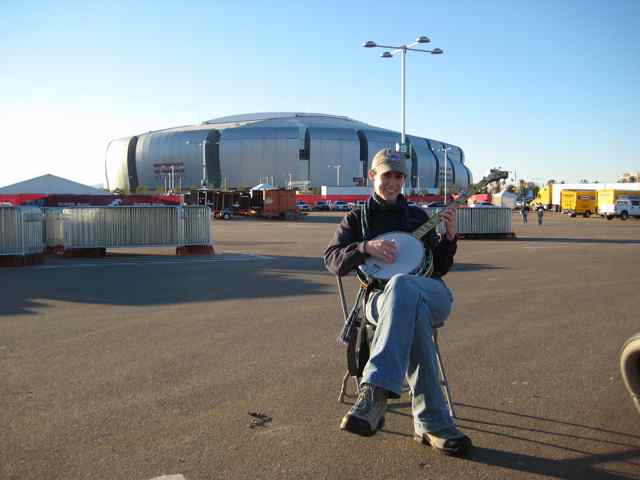
Casey Henry
Banjo Player
I hope to add my articles to my site as I get the time. That will probably be very slowly...but I'll get them all up here eventually!
Article of the Month: The Banjo and the Super Bowl
This article appeared in the April 2008 issue of Banjo Newsletter magazine
Banjos sometimes pop up in places you wouldn’t expect. In space, for instance, when astronaut Marsha Ivins used Alison Brown’s “Girl’s Breakdown” as a wake-up call on the space shuttle Destiny’s mission to the International Space Station. Or at the Super Bowl.
Now, I know banjo is not the first thing that comes to mind when you think of the Super Bowl, or even the fifth or thirtieth. But there is a connection. Banjo player Cap Spence has been the staging supervisor for the halftime show for the last eight years. He is a Murphy Method student and has attended several camps where Murphy and I have taught. This year he asked me if I’d like to come out to Glendale, AZ, and work on the show as a volunteer coordinator. (I wasn’t a volunteer, I was paid to coordinate the volunteers.) Hmm…two weeks in Arizona in January, working on a show that millions of people are going to watch…okay!
He, in a moment of great optimism, asked me to bring my banjo in the hopes that we’d have time to work in a lesson or two in the vast amounts of spare time that we’d both have. HA! Not only did we not get to play the banjo together, I was so busy I only played it one day, period.
The trick to the Super Bowl halftime show is that the stage, complete with all the sound equipment, lights, and pyrotechnic effects, has to get set up on the field in five minutes, and get rolled off the field in five minutes. It sounds impossible, but with the right kind of organization and practice Cap manages to pull it off. The people who push the sections of stage (called carts) onto the field are mostly volunteers, recruited from the local area. This year there were slightly more than four hundred people for more than forty carts.
In the two weeks prior to the game there are several rehearsals for the stage crew. In order to get the volunteers thinking and working like an organized unit, Cap begins the practices with a story. Each story has a theme. The first night’s story, on the subject of accomplishing a seemingly impossible task, is about building the transcontinental railroad. On succeeding nights he talks about experiences in his life that demonstrate the appropriate theme: plowing with a mule (pick a spot and go there), or working on a pig farm (get the job done by whatever means necessary). But his most pertinent story, for the purposes of this magazine anyway, is on the theme of time: “speed is not important when learning to play the banjo.”
All the Murphy Method students out there should recognize this phrase as straight off of any number of Murphy Method videos. It is one of Murphy’s mantras. To put it less succinctly, it means that you don’t achieve speed by just trying to play something as fast as you can. That approach results in missed notes, bad timing, and sloppy playing. Speed is a result of precision; if you learn something right and are playing it correctly, speed will come by itself the more you practice, most likely without you even noticing.
Cap tells the volunteers about his journey of learning to play the banjo in his middle age. He tells them about Murphy and her DVDs and about how she drills the “speed is not important” point home in every lesson. Then he expands the point and explains how the same principal can be applied to the process of assembling the large halftime stage. Each cart can weigh as much as a car, so moving them around quickly can be dangerous if people aren’t paying attention. Whereas, trying to speed up too quickly when playing banjo causes messy playing, in this case it can result in accidents and potentially serious injury. So, with thoughts of banjos dancing in their heads, our volunteers move those carts with careful accuracy and, for eight years running, have done the job with no major accidents.

To accompany his banjo story, Cap has always wanted to be able to demonstrate on his own banjo, starting out playing a tune so slow as to be unrecognizable, and then gradually speeding up until it magically transforms into “Foggy Mountain Breakdown.” He hasn’t quite gotten up the nerve to try it, so he was hoping I could be his banjo demonstrator this year. Unfortunately it got too cold at night to do that, but we’re aiming for next year—in Tampa. I did get out the old five and play for the volunteers one evening as we were checking them in, before the sun went down and the temperature dropped. They all wanted to hear “The Ballad of Jed Clampett.” One guy even tipped me a quarter. Yes, this is the big time.
Now for a story that falls under the category of, well, I don’t think there is a category for this, but if you think of one let me know. I was sitting at my kitchen table one rainy night in January and I heard a sharp noise from the living room. It was a crack, or a pop, as if from a humongous Rice Krispie. I didn’t think much of it since my house is old and makes all sorts of noises. Then it happened again. And again. Finally I realized I better figure it out, so I walked in the living room and turned on the light to see my banjo, lying in the open case in the middle of the floor (that’s where I keep it, you know). On the head were three drops of water. I looked up at my ceiling and saw a fourth drop getting ready to join the first three. I gently yanked my banjo out from beneath the impending missile, carefully dried off the head, and then climbed the ladder to the attic and put a bucket under the leak. Had my banjo not been there the roof could have leaked for hours onto the rug below and I never would have heard it. Thank goodness for banjos.